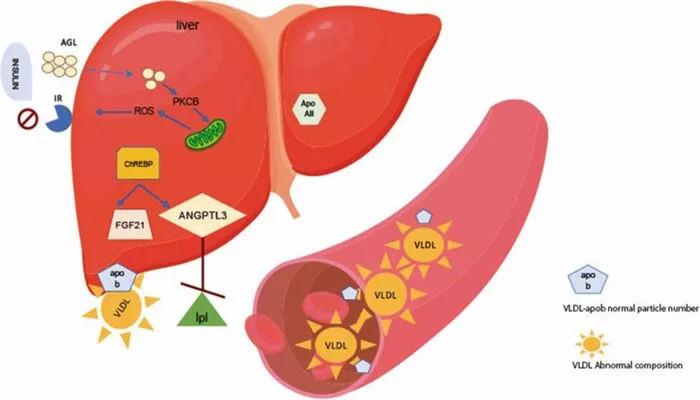Hypertriglyceridemia (HTG) is a medical condition characterized by elevated levels of triglycerides in the bloodstream.
Triglycerides are a type of fat (lipid) that the body uses for energy. While they are essential for normal bodily functions, excessively high levels can lead to serious health issues, including cardiovascular disease and pancreatitis. This article delves into the causes, classifications, symptoms, diagnosis, and management of hypertriglyceridemia.
What Are Triglycerides?
Triglycerides are the most common type of fat found in the body. They are derived from the food we consume and are also produced by the liver. When you eat more calories than your body needs, it converts those extra calories into triglycerides, which are stored in fat cells. The body releases these triglycerides for energy between meals.
Normal Triglyceride Levels
Normal fasting triglyceride levels are considered to be below 150 mg/dL (1.7 mmol/L). Levels are classified as follows:
| Triglyceride Level | Category |
| Less than 150 mg/dL | Normal |
| 150-199 mg/dL | Borderline High |
| 200-499 mg/dL | High |
| 500 mg/dL or higher | Very High |
What Is Hypertriglyceridemia?
Hypertriglyceridemia is defined as having triglyceride levels of 150 mg/dL or higher. It can occur in both primary forms, which are often genetic, and secondary forms, which result from lifestyle factors or other medical conditions.
Primary Vs. Secondary Hypertriglyceridemia
Primary Hypertriglyceridemia: This form is usually inherited and can be due to genetic mutations affecting lipid metabolism.
Secondary Hypertriglyceridemia: This form is more common and can result from factors such as obesity, diabetes, excessive alcohol consumption, and certain medications.
SEE ALSO: Does Exercise Lower Ldl?
Causes of Hypertriglyceridemia
Several factors can contribute to elevated triglyceride levels:
Diet: High intake of sugars, refined carbohydrates, and unhealthy fats can raise triglyceride levels.
Obesity: Excess body weight is a significant risk factor.
Physical Inactivity: Sedentary lifestyles contribute to higher triglyceride levels.
Medical Conditions: Conditions like diabetes, hypothyroidism, and liver disease can lead to hypertriglyceridemia.
Medications: Certain drugs, including corticosteroids and some beta-blockers, may elevate triglyceride levels.
Symptoms of Hypertriglyceridemia
Hypertriglyceridemia itself is often asymptomatic; however, extremely high levels may lead to complications such as:
Eruptive Xanthomas: These are small yellowish lesions that appear on the skin.
Palmar Xanthomas: Yellowish patches on the palms.
Acute Pancreatitis: Severe abdominal pain that may occur if triglyceride levels exceed 1000 mg/dL (11.3 mmol/L).
Diagnosis of Hypertriglyceridemia
Diagnosis typically involves a blood test measuring fasting triglyceride levels. Additional tests may be conducted to identify underlying causes or associated conditions:
Fasting Lipid Panel: Measures total cholesterol and triglyceride levels.
Comprehensive Metabolic Panel: Assesses overall metabolic health.
Apolipoprotein B Testing: Evaluates the number of LDL particles.
Risk Factors for Diagnosis
Certain risk factors increase the likelihood of developing hypertriglyceridemia:
Family history of hyperlipidemia
High-fat diet
Sedentary lifestyle
Obesity
Diabetes mellitus
Excessive alcohol consumption
Complications Associated with Hypertriglyceridemia
Hypertriglyceridemia can lead to several serious complications:
Cardiovascular Disease
Elevated triglyceride levels are associated with an increased risk of atherosclerosis, which can lead to heart attacks and strokes. The American College of Cardiology recognizes hypertriglyceridemia as a risk-enhancing factor for cardiovascular disease.
Acute Pancreatitis
Severely elevated triglyceride levels (greater than 1000 mg/dL) can cause acute pancreatitis, a potentially life-threatening condition characterized by inflammation of the pancreas.
Management And Treatment of Hypertriglyceridemia
Management strategies for hypertriglyceridemia focus on lifestyle changes and medication when necessary.
Lifestyle Modifications
Dietary Changes:
Reduce intake of sugars and refined carbohydrates.
Limit saturated fats and trans fats.
Increase omega-3 fatty acids through fish or supplements.
Physical Activity:
Aim for at least 150 minutes of moderate-intensity exercise per week.
Weight Management:
Achieving a healthy weight can significantly lower triglyceride levels.
Alcohol Reduction:
Limiting alcohol intake can help manage triglyceride levels effectively.
Medications
When lifestyle changes alone do not adequately lower triglyceride levels, medications may be prescribed:
Fibrates: These drugs lower triglycerides by reducing liver production.
Statins: Primarily used to lower LDL cholesterol but may also reduce triglycerides.
Prescription Omega-3 Fatty Acids: These can significantly lower triglyceride levels.
Conclusion
Hypertriglyceridemia is a significant health concern that requires attention due to its association with cardiovascular disease and pancreatitis. Understanding its causes, symptoms, diagnosis, and management strategies is crucial for effective treatment and prevention. By adopting a healthy lifestyle and working closely with healthcare providers, individuals can manage their triglyceride levels effectively and reduce their risk of serious health complications.
SEE ALSO:
- Is Rice Harmful to Cholesterol?
- How Hyperlipidemia Cause Pancreatitis
- Does Jogging Reduce Cholesterol?

